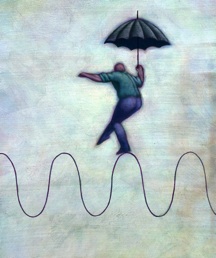 Among my favorite essays on loving someone with a mental illness are those penned by Anna Bishop, my blogging buddy James’s wife. She’s written five outstanding posts on what it’s like to be a passenger on the rollercoaster of a marriage with a person diagnosed with bipolar disorder.
Among my favorite essays on loving someone with a mental illness are those penned by Anna Bishop, my blogging buddy James’s wife. She’s written five outstanding posts on what it’s like to be a passenger on the rollercoaster of a marriage with a person diagnosed with bipolar disorder.
Here are the links to her first four articles:
“The Depression Dialog”
“Know the Enemy”
“Trigger Unhappy”
“Keeping Your Mind Together”
The fifth piece in the series is called “Loving the Person You Care For,” and I have excerpted from it below.
I’ve written a lot about being a carer in my last 4 posts, but in this one I’d like to share with you the book that really saved my own sanity. It is “Loving Someone with Bipolar Disorder” by Julie A. Fast and John D. Preston.
In the first few months after James’ diagnosis I read a lot of material to educate myself. The problem was that most of it was factual information on depression and bipolar, but it didn’t tell me how to manage practical things like James’ irritability. The info simply described the symptom without ideas for its management.From pages 1 to 2: “This book can provide you with the tools you need to be a resource and support for your partner instead of a crisis manager and constant caretaker.” This is exactly what I needed!
The book was written specifically for carers. Julie Fast has bipolar disorder, as does her partner of 10 years, and the result is a book with real insight.
At its heart is the idea of creating a holistic treatment plan.
The first aim is to develop a symptom list that you can use to identify when your partner’s behavior starts to change. Once that has been worked out the second aim is to create a “what works list” to treat those symptoms before they progress to a full blown episode. The third step is to work out what triggers the symptoms in the first place. These are often outside events, situations or behaviors that once modified or eliminated really make your partner far more stable. Once you understand the triggers well, then the goal is to stop the mood swing from starting in the first place. If it does start then the “what works list” comes into play.
Of course this strategy requires recording your partner’s behavior over time e.g. by keeping a journal.
The rest of the book focuses on the needs of the carer. (Obviously your partner achieving greater stability is already a significant help).The chapter on “Your Emotional Response” starts you on the road of looking after your own needs. It discusses issues like anger, grief, guilt and feeling trapped. For me, it was almost a springboard for seeing a counselor.
The chapters on work, money and sex cover practical issues that cause distress. They were all helpful chapters, but for me the chapter “The Hard Truths” had more impact. This chapter really lays it on the line and forces you to face the reality of your relationship. Are you prepared to stay with your partner if things don’t change? Tough reading.
My favorite chapter is “The Bipolar Conversation”, which teaches you how to avoid pointless fights when you partner is baiting you. The book ends with “Laughter and Joy”, an inspiration to leading a normal life again. From this I learned to structure in happy times in our lives.A brilliant book. It may be about bipolar, but the application is much wider and relevant to all mood disorders. It would greatly help any carer living with a depressed partner.

